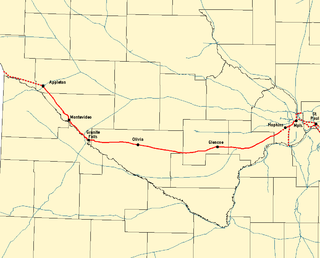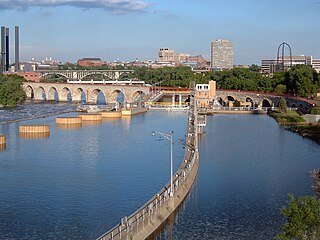Related Research Articles

The Metro Blue Line is a 12-mile (19.3 km) light rail line in Hennepin County, Minnesota that extends from downtown Minneapolis to the southern suburb of Bloomington. The line was originally named after Hiawatha Avenue which runs parallel to a good portion of the line. Major locations on the line include the Mall of America, Minneapolis–St. Paul International Airport and Target Field in downtown Minneapolis.

The Northstar Line is a commuter rail route in the US state of Minnesota. Northstar runs 40 miles (64 km) from Big Lake to downtown Minneapolis at Target Field using existing track and right-of-way owned by the BNSF Railway. Passenger service began on November 16, 2009. The rail line serves part of the Northstar Corridor between Minneapolis and St. Cloud. Planning for the line began in 1997 when the Northstar Corridor Development Authority (NCDA) was formed. The corridor is also served by Interstate 94 and U.S. Highway 10.
Metro Transit is the primary public transportation operator in the Minneapolis–Saint Paul area of the U.S. state of Minnesota and the largest operator in the state. The system is a division of the Metropolitan Council, the region's metropolitan planning organization (MPO), averaging 264,347 riders each weekday, carrying 90% to 95% of the transit riders in the region on a combined network of regular-route buses, light rail and commuter rail. The remainder of Twin Cities transit ridership is generally split among suburban "opt-out" carriers operating out of cities that have chosen not to participate in the Metro Transit network. The biggest opt-out providers are Minnesota Valley Transit Authority (MVTA), Maple Grove Transit and Southwest Transit. The University of Minnesota also operates a campus shuttle system that coordinates routes with Metro Transit services.

The Metro Green Line is an 11-mile (18 km) light rail line that connects the central business districts of Minneapolis and Saint Paul in Minnesota as well as the University of Minnesota. An extension is under construction that will extend the line to the southwest connecting St. Louis Park, Hopkins, Minnetonka and Eden Prairie. The line follows the path of former Metro Transit bus route 16 along University Avenue and Washington Avenue. It is the second light-rail line in the region, after the Blue Line, which opened in 2004 and connects Minneapolis with the southern suburb of Bloomington.

Saint Paul's Union Depot is a historic railroad station and intermodal transit hub in the Lowertown neighborhood of the city of Saint Paul, Minnesota, United States. It serves light rail, intercity rail, intercity bus, and local bus services.

The Minneapolis, Northfield and Southern Railway was an 87-mile (140 km) long American shortline railroad connecting Minneapolis and Northfield, Minnesota. It was incorporated in 1918 to take over the trackage of the former Minneapolis, St. Paul, Rochester and Dubuque Electric Traction Company, also known as the Dan Patch Lines. On June 2, 1982, it was acquired by the Soo Line Railroad, which operated it as a separate railroad until merging it on January 1, 1986 along with the Chicago, Milwaukee, St. Paul and Pacific Railroad.

The Mall of America station is the busiest transit center in Minnesota, with bus and light rail service linking the Mall of America to many destinations in the Minneapolis–St. Paul metro. Public transit service is provided by Metro Transit and the Minnesota Valley Transit Authority. The station is served by METRO Blue Line and Red Line. The station previously hosted private shuttle services to hotels and Mystic Lake Casino until those services moved to a new charter bus terminal on the north side of the mall in 2015.

The Twin Cities and Western Railroad is a railroad operating in the U.S. state of Minnesota which started operations on July 27, 1991. Trackage includes the former Soo Line Railroad "Ortonville Line", originally built as the first part of the Pacific extension of the Milwaukee Road. This main line extends from Hopkins, Minnesota to Appleton, Minnesota. The line was originally built between Hopkins and Cologne, Minnesota in 1876 by Hastings and Dakota Railroad. In 1913, the Milwaukee Road rerouted it, reducing the curves. The line was eventually extended to the Pacific.

Transportation in the U.S. State of Minnesota consists of a complex network of roadways, railways, waterways and airports. The transportation system is generally overseen by the Minnesota Department of Transportation, a cabinet-level agency of the state government. Additionally, regional governments such as the Metropolitan Council have authority over regional planning for the transportation system and local governments such as cities and counties oversee the local transportation network.
The METRO Purple Line, formerly known as the Rush Line Corridor, is a proposed bus rapid transit service that would run from Union Depot in downtown Saint Paul to downtown White Bear Lake. Along the corridor's 21 proposed stations there are 106,000 jobs within a 10-minute walk. The project is currently in an environmental analysis phase with further development, engineering, and construction expected to take at least six more years. Service would run 7-days a week with 10-minute headways in peak periods and 15-minute service at most other times. The corridor is named the Rush Line because it was originally planned to end in Rush City, Minnesota. After using the color purple since 2017, the route was officially named the Purple Line and became part of the METRO network on July 14, 2021.

Target Field Station is a multimodal commuter train and light rail station in Minneapolis, Minnesota. Located in the North Loop area of Downtown Minneapolis, the station is named for Target Field, the Minnesota Twins baseball stadium. METRO Blue Line light rail service started November 14, 2009; Northstar Line commuter rail service started November 16, 2009; METRO Green Line light rail service started on June 14, 2014.
The Bottineau LRT is a proposed light rail line extension in the Minneapolis – Saint Paul Metro area, projected to run northwest from Target Field station in downtown Minneapolis along County Road 81 to Brooklyn Park.
The Riverview Corridor is a transit corridor connecting Downtown Saint Paul and the Mall of America in Bloomington via the Minneapolis-Saint Paul International Airport. The corridor serves an area from the Saint Paul Union Depot to the Mall via parts of the METRO Green Line and the METRO Blue Line, and a route running parallel to West 7th Street, which runs southwest from Downtown Saint Paul. The corridor creates a triangle connecting opposite ends of the Blue Line and Green Line.
There are several passenger rail projects being discussed in Minnesota. There is one existing commuter rail service in the state, the Northstar Line, and one existing long-distance intercity rail service, the Empire Builder. Future projects include a mixture of short-distance commuter rail and medium-distance regional rail lines which would run from the Twin Cities outward to neighboring states and perhaps Canada.

The METRO Orange Line is an under construction bus rapid transit line in the Twin Cities, Minnesota. The line will operate primarily along Interstate 35W from downtown Minneapolis through Richfield and Bloomington before terminating in Burnsville, Minnesota. The Orange Line will provide access to 198,000 jobs with roughly a quarter of them outside downtown Minneapolis. The route will serve a mix of stations located in the center of the highway, stations near highway exits, and on-street stations. The line will have features typical of bus rapid transit systems with off-board fare payment, articulated buses with extra doors, stations with improved passenger amenities, and transit-only bus lanes on portions of the route.
The Northern Lights Express (NLX) is a planned higher-speed rail service that would run 155 miles (249 km) between Minneapolis and Duluth primarily in the U.S. state of Minnesota. A portion of the proposed line would run through neighboring Wisconsin to serve Duluth's "Twin Port" of Superior. Plans are to upgrade an existing BNSF Railway freight line to allow trains to travel at up to 90 miles per hour (145 km/h). The train service is said to provide an alternative to traveling Interstate 35 between Duluth and the Twin Cities or to other destinations along the line such as the casino in Hinckley.

The Dan Patch Corridor is a proposed commuter rail line that would serve a region which runs from Minneapolis to Northfield, Minnesota. The corridor consists of the tracks on the former Minneapolis St. Paul Rochester and Dubuque Electric Traction Company lines, which came to be known as the Dan Patch lines. It was proposed as a passenger rail line in 2000 after being identified as a "Tier One" corridor in the Minnesota Department of Transportation's 2000 Commuter Rail System Plan before being given a study ban during the 2002 Minnesota legislative session. It sat in relative silence until 2008, when bills were introduced in the Minnesota State Legislature to potentially revive discussion.
The MN&S Spur is a 18.5-mile (29.8 km) railroad line operated by the Progressive Rail Inc. The route runs through suburbs immediately west of Minneapolis, Minnesota, from MN&S Junction in Crystal south to Auto Club Junction in Bloomington near the Minnesota River. This path is parallel to Minnesota State Highway 100, which is about half a mile east of the rail line.

Metro is a high-capacity rapid transit network serving the Minneapolis-Saint Paul metropolitan area. As of 2020, the system consists of two light rail lines and three bus rapid transit lines operated by Metro Transit. The five lines connect Downtown Minneapolis and St Paul with Bloomington, Minneapolis-St Paul International Airport, Roseville, and Brooklyn Center, with several new lines and extensions in the planning stages.
References
- ↑ Coleman, Toni (March 1, 2002) "BUSWAY PROJECT PUT ON HOLD//BUDGET BILL RECLAIMS MOST OF STATE FUNDING" Saint Paul Pioneer Press
- ↑ Coleman, Toni (August 23, 2000) "OPTIONS DETAILED FOR EAST METRO TRANSIT//LIGHT RAIL, BUSWAY AMONG RIVERVIEW CORRIDOR CHOICES" Saint Paul Pioneer Press
- ↑ Coleman, Toni (November 7, 2001) "EAST SIDE WELCOMES COMING OF BUSWAY//RECEPTION IS IN CONTRAST WITH WEST SEVENTH'S" Saint Paul Pioneer Press
- ↑ Coleman, Toni (January 6, 2003) "EXPRESS BUS MAY COME TO WEST SEVENTH AFTER ALL" Saint Paul Pioneer Press
- ↑ Blake, Laurie (January 12, 2003) "Bus service improvements ahead" Star Tribune
- ↑ "City of Saint Paul Council Meeting Minutes". City Council Meeting Minutes. City of Saint Paul. p. 2.
- ↑ "MnDOT Commuter Rail System Plan, Section 1" (PDF). Minnesota Department of Transportation. 2000. Retrieved 2008-04-09.